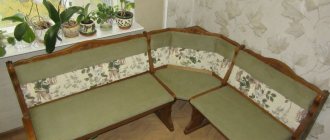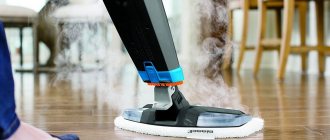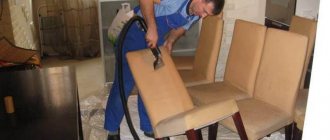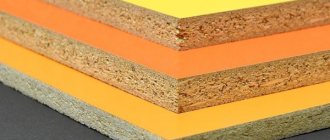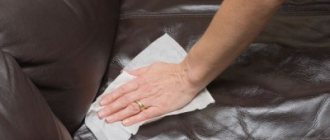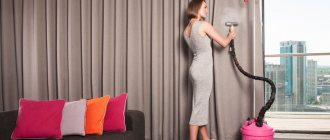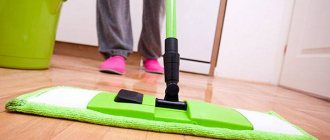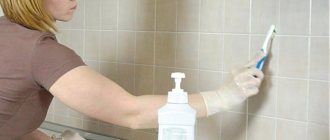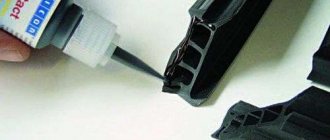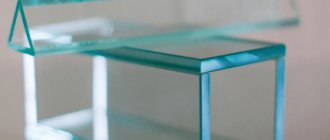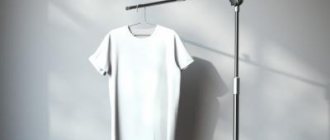When we choose fabric for upholstery in a bedroom, living room or children's room, we first of all pay attention to the color, texture and how its color will fit into the interior. But when it comes to choosing fabric for upholstering a kitchen corner, furniture fabric needs to be selected according to slightly different criteria. Because it is important to take into account that the kitchen is a room with high humidity and frequent temperature changes. The upholstery of kitchen furniture gets dirty more often and is more susceptible to dirt than in other rooms. What furniture fabric is ideal for upholstering a kitchen corner? Let's figure it out.
Choosing the right material
Any material can be used to reupholster a kitchen corner. Restoration is especially useful for those who want to change the interior, add modern notes, and show imagination. Textile is the most popular upholstery material. You can choose the most suitable fabric in terms of color and characteristics. The most common include:
Often, to renovate a kitchen corner, people choose artificial leather. Externally, as well as in properties, it is not inferior to natural, the cost is much less. The disadvantages include the fact that leatherette does not “breathe”. In addition, thin material will soon wear out, crack or tear, so it is necessary to select it correctly. It is optimal to use the following fabrics:
Genuine leather is the most expensive material. Fits perfectly into the kitchen interior and emphasizes the taste, style, and social status of the homeowners. In addition, she needs extremely careful treatment:
To cover furniture, you need to calculate the required amount of material. You should remove the old upholstery from the corner and measure the protruding parts. After this, you need to add up the resulting vertical dimensions and add about 20% for allowances. The required width of the material is determined by the widest part of the old upholstery.
In standard furniture options, foam rubber is usually used as a filler; it is cheap, but very quickly loses its elasticity. Sintepon has the same characteristics. A more expensive, but high-quality option is polyurethane foam. It will last several times longer than other fillers. To make the design of the kitchen corner brighter, you can use different materials and even contrasting colors for the back and seat, for example, black and white, yellow and blue. The choice is unlimited - even light-colored furniture can be practical if the right, easy-to-care fabrics are chosen.
Stages of work
Upholstering a corner in the kitchen does not require any special professional skills. All you need is caution, accuracy, endurance and patience. Before reupholstering a piece of furniture, you need to carefully think through the algorithm of actions and follow it.
Removing the upholstery
To remove the upholstery you need to:
Cutting fabric
You will not be able to get a good result if you initially cut the fabric or cut the stuffing incorrectly. It is best to use the same material as a pattern. In a situation where the new sheathing has a high density, it is necessary to add 2 cm to the linear measurements. A flap that is too small will not allow the material to be pulled over the frame, leaving a tensile allowance. As a result, the fabric will deteriorate and the furniture will need to be restored again. It is also necessary to leave allowances for the hem. The filler is usually simply cut along the contour of the part of the product to which it will be glued. To maintain the shape, 1 cm is added on all sides during cutting. When fastening, glue or staples are used.
Calculation of filler amount
Frame repair
Before restoring a corner, it is necessary to inspect each element and determine wear. Applying the correct markings and carefully performing each operation helps to minimize difficulties during assembly. Restoration of a wooden frame is carried out as follows:
It is worth remembering that painting also includes a preliminary primer, so the color will lie more evenly. Repairing frame elements is a necessity when reupholstering a corner in the kitchen. Parts of the structure that have become unusable must be repaired or replaced. If there are minor chips or cracks, they can be filled with glue.
Padding
The procedure is performed step by step:
When the furniture design is complex or the padding material is too thin, the piece is tightened with a carriage tie. Furniture nails are used as fasteners. This allows you to significantly increase the service life of the restored corner.
Assembly
The reupholstered kitchen corner is assembled in the reverse order. In places where there should be fastenings, it is better to drill holes in advance, this will prevent damage to the structure. Initially, the folding elements are fixed with hinges. Then the resulting structure is attached to the pallet, and only then the supports are attached to it. Next, the seat and backrest are mounted to the first side panel, and then to the second. The legs are installed at the very end.
Since kitchen furniture wears out quite quickly, reupholstering corners is a popular procedure. You can turn to professionals or do everything yourself. It's not difficult even at home. It is only important to carry out all the calculations correctly. An updated kitchen corner makes it possible to save money and revitalize the interior.
How to tighten it with your own hands?
To restore a kitchen corner yourself at home, you need to understand the sequence of actions of this process. It is worth considering the main stages of remodeling old furniture and its complete transformation.
- Removing old upholstery from a kitchen corner using a staple remover or a tool you have at home for removing furniture staples. It is better not to throw away the material; it will be useful for cutting new upholstery.
- Remove the old layer of foam rubber so that there are no residues. If the foam rubber was glued, then it will be possible to remove it completely only with the help of a knife.
- Cut out new upholstery using old samples. The new pattern must exactly match the one that was previously eliminated, otherwise replacing one with another will be problematic. It is best to mark the edges of a new product using chalk or a bar of soap so that the incorrectly made part can be easily erased. When cutting out a pattern, it is important to leave 5 cm on each side to make starts that will tuck during attachment to the furniture frame. It is recommended to buy material with a reserve so that there is enough of it during cutting. If there is anything left after creating the patterns, you can use the fabric for its intended purpose and update chairs or stools, and, if desired, make soft cushions for the future kitchen corner.
- The finished templates are sewn together using a sewing machine. It is worth making several seams to maximize the strength of the structure and prevent it from coming apart in the future.
- Repairing a kitchen corner also involves replacing the soft component, so it is necessary to lay new foam rubber and secure it. For fixation, you can use various glues: construction glue, from a gun or “Moment”. If there is no desire or need to attach the soft component to the frame, you can connect it to the upholstery, securing it with furniture nails or staples.
- The final touch will be putting new covers on the kitchen corner and checking their size. If something needs to be redone, there is still an opportunity for this. As soon as everything is in place, the most important stage begins, in which you should not rush - this is attaching new upholstery to old furniture. You can work using an industrial stapler, which quickly and securely fixes staples to the base of furniture. The staples should be spaced quite often, at least 4 cm between each of them, otherwise the material will begin to turn out, which will spoil the impression of the work performed.
- If you managed to sheathe all the parts of the kitchen corner frame, then you can put all the parts together, put the furniture away and try to use it.
Working step by step, you can achieve the desired result and update old furniture in the kitchen, completely transforming it, and, if desired, radically changing it.
If you carry out the work correctly and follow the advice, you can replace damaged and worn upholstery in the kitchen within one day, enjoying the results for many years.
Advantages of self-upholstery
For a novice home craftsman, reupholstering kitchen corners is not difficult. Simple design, availability of materials, simple manipulations simplify the process. Advantages of independent work:
Companies offer calling a specialist to your home, taking measurements or removing furniture for subsequent restoration. All this is not cheap, and it takes a lot of time. Therefore, independence is more appropriate here.
A high-quality result cannot be achieved without disassembly, so you will have to spend time disassembling the structure and removing elements. This will allow you to change the coating without damaging other surfaces.
The owner independently assesses the condition of the structure. To strengthen it you will need fittings and suitable fasteners. To update the appearance of wooden panels, you will have to resort to using paint and varnish. To facilitate the process, tools and materials are prepared in advance.
What is furniture reupholstery?
Reupholstery is the replacement of upholstery and lining materials. Often, high-quality work results cannot be achieved without disassembling the furniture. The upholstery of many kitchen corners can only be updated by disassembling the structure into individual elements. It is easier to remove the old coating from them without causing damage to other parts. In most cases, repairing a kitchen corner is not limited to reupholstery, since you have to strengthen the frame of the sofa, cover it with varnish or paint, change fasteners, accessories, etc.
Selection of materials
Restoration of kitchen corners requires a careful approach to the choice of material, taking into account operating conditions. Coloring, unusual texture, original design of the canvas are less important than wear resistance and quality. The material is chosen so that you don’t have to reupholster it every year, and the appearance is preserved as long as possible.
When choosing material for upholstery, preference should be given to non-marking colors. High-quality fabric is easy to clean; a budget option is more difficult to get rid of stains. It is better to take measurements based on the dimensions of the removed upholstery. If the kitchen is made in the same style, then the material must match in color and texture. The use of contrasting shades for backs and seats is popular. In this case, the corner will become a fashionable accent in the kitchen.
The upholstery of kitchen corners suffers from frequent use, and the fillings lose their elasticity. Sheets of foam rubber are placed inside. In order not to make a mistake with the size, add a centimeter to the measurements on each side.
Stages of work
Do-it-yourself reupholstery of a kitchen corner consists of the following steps:
If the condition of the corner is unsatisfactory, then the replacement of drawers, panels and restoration of wooden parts will be added to the stages of work. Additionally, you may need to purchase and install new fittings and strengthen structural elements (if they are loose). Poor quality material wears out more over time, creating an additional problem - repairing weak bolts. Broken sockets are expanded with a drill, dowels are inserted (they are pre-coated with PVA). After the glue has completely dried, you can continue assembling the structure. Self-tapping screws must be used for fastening.
Removing the upholstery
The entire process of removing upholstery, in the case where the design is the same as a non-separable sofa and the corner is completely covered with fabric, comes down to the following points:
The process of removing the upholstery when the kitchen corner looks like a simple bench with a soft seat and back is divided into several stages:
The removed fabric will be used to clarify measurements, so its integrity must be preserved. Damaged or torn material will not allow you to determine the exact dimensions; for this reason, the structure itself is measured with an allowance for bending.
Cutting fabric and filling
How to renew a kitchen corner after disassembling and removing the upholstery - more on this below. It will not be possible to achieve a high-quality result if you do not cut the fabric or cut the stuffing in advance. Previously removed material is used as a pattern. It is desirable that each element is sheathed in one piece. If this is not possible, then you will need to fasten the flaps together before laying out and tracing the pattern.
If the new upholstery is much denser than the old one, you need to add a couple of centimeters to the measurements. A flap that is too small will not allow enough tension in the fabric. As a result, the material will be damaged, and you will have to take measurements and cut it again.
The master must leave allowances that will be used for tucking and fastening. It is easier to work with the filler; it is simply cut along the contour of the piece of wood or plywood to which it will be glued. To keep the shape longer, add one centimeter to each side when cutting the filler. When fastening, you can use glue or staples (fixation in increments of up to 100 mm).
Frame repair
The design of most furniture quickly deteriorates. Before you reupholster the kitchen corner with your own hands, you need to inspect all the elements for wear. Accurate markings and careful, careful work without haste will help you avoid problems during subsequent assembly. One of the common problems is peeling coating on the legs.
Restoration of wooden parts takes place in several stages:
Any wooden element may require restoration, but a primer is needed before using varnish or paint. In the case when parts of the furniture are replaced with new ones, it is necessary to mark and drill holes in advance for subsequent fastening. Frame repair is a common need when reupholstering a kitchen corner. Elements that have fallen into disrepair are restored. If the wooden legs have lost their former luster or the coating has peeled off, then they are cleaned of external contaminants, sanded, varnished or painted. If cracks or gaps appear in the frame, they are filled with wood glue.
In case of significant damage, the part can be replaced entirely by cutting it out of chipboard. Accuracy and precise markings will make it easier to assemble furniture with a new element. In this case:
To reliably glue the parts of the structure together, experts advise using clamps. They will press down on glue-coated surfaces without having to hold them with your hands. Clamps enhance the adhesive properties of the material and allow you to securely fasten parts.
Reupholstery and assembly
Re-upholstery and assembly are carried out step by step:
If the design is complex or the padding is too thin, then we tighten the surface with a carriage tie. Furniture nails can be used as fasteners. This will increase the service life of the new coating.
Reassemble the kitchen corner in the reverse order of disassembly. Where the fasteners will subsequently be, all holes are drilled in advance. This will help avoid damage to the upholstery and filling. The duration and complexity of the work depend on the design. For example, when assembling a sofa from three components, the sequence of actions does not change, only the corner part is assembled first, and then the side parts.
Required Tools
The master will need the following tools:
- hammer;
- drill-driver;
- mites;
- spanners;
- stationery knife;
- glue;
- stapler;
- anti-stapler;
- scissors;
- marking tool.
All of the above is a minimum set. If the design is too complex, then additional tools will be needed. The consumables used are staples, glue, chalk, and furniture nails. If the condition of the furniture is completely deplorable, then you will need suitable fasteners, a jigsaw, sandpaper, and a pry bar. A screwdriver and wrenches will help you disassemble the structure. An anti-stapler and a knife are useful for removing upholstery.
The filler is not always easy to remove. If the manufacturer glued foam rubber, you will have to remove it with a knife and then clean the surface. High-quality glue will allow you to glue the upholstery (a special one is used), and a stapler will allow you to secure the fabric (furniture nails will also work). A knife is recommended for cutting material, and scissors and chalk are recommended for cutting.
How to decorate
The updated kitchen corner can be left unchanged or decorated. Several popular decoration options:
For decoration, stencils are used that will help you apply designs of varying degrees of complexity onto wooden panels. The use of fringe or tassels is no longer relevant. A repeating pattern is applied to the arms, legs and small plain elements.
You should not use more than two ways to decorate a kitchen set. Too much decoration will ruin the appearance of the corner. It is better to opt for a more concise option.
The decoupage technique should be used with caution. For decoration, one color scheme and one type of pattern are used. If the kitchen already has furniture or appliances decorated in the same way, then it is better to abandon this idea. Otherwise, the appearance will be rustic and rustic.
Even a novice craftsman can reupholster a kitchen corner. The main thing is to strictly follow the step-by-step instructions, do the work carefully and without haste. Updated furniture will decorate the kitchen.
Choosing upholstery for the kitchen corner
When we choose fabric for upholstery in a bedroom, living room or children's room, we first of all pay attention to the color, texture and how its color will fit into the interior. But when it comes to choosing fabric for upholstering a kitchen corner, furniture fabric needs to be selected according to slightly different criteria. Because it is important to take into account that the kitchen is a room with high humidity and frequent temperature changes. The upholstery of kitchen furniture gets dirty more often and is more susceptible to dirt than in other rooms. What furniture fabric is ideal for upholstering a kitchen corner? Let's figure it out.
What tools are needed
To restore the kitchen corner you will need the following tools:
- a knife or screwdriver to remove old staples; in the professional world, an anti-stapler is used;
- hammer;
- a painting or stationery knife designed for cutting foam rubber;
- keys, with the help of which the frame of the corner is dismantled until the final completion of the reconstruction of the upholstery;
- sewing machine - used for sewing new upholstery;
- furniture cardboard – ensures high-quality, even stitching of upholstery;
- stapler for paper clips - they are used to fasten the fabric to the frame;
- accessories - intended for additional decor;
- glue - used to attach foam rubber.
Textile or leather upholstery
Many people ask which kitchen upholstery is better - fabric or leather. These furniture fabrics differ both in price and in their performance characteristics. Among the advantages of textile upholstery is its amazing tactile qualities. This fabric is pleasant to the touch and looks very homely. In turn, leather has another undeniable advantage - it looks very elegant and presentable. But, unfortunately, the skin does not like temperature changes and can deteriorate as a result. Therefore, if the interior is primarily important to you in the kitchen and you don’t cook very often, feel free to choose leather upholstery. If you like to pamper your household with delicious pastries, it is better to choose fabric upholstery.
How to sew a cover yourself
To protect the upholstery, you can use a corner cover. First you need to choose the shape of the cover and fabric. Draw it yourself or find the appropriate pattern on the Internet. Take some old fabric, cut it according to the patterns and sew it.
You can use leather or fabric upholstery on the sofa.
Try the resulting draft on your corner. If any defects are found, correct them. If you are satisfied with how the trial version fits on the corner, then proceed to cutting out the main material. Sew in zippers and clasps if necessary. Decorate the case as you wish.
Choose the color of the fabric based on the interior design of the kitchen.
Place the finished cover on your kitchen corner. But don’t get carried away with decorating too much, because this is a cover designed for a kitchen corner, and an abundance of decorative elements will look inappropriate there.
The leather upholstered corner is easy to use and care for.
Jacquard, velor or flock
Now let's decide on the type of fabric. Furniture fabrics such as chenille, jacquard, velor, and flock are perfect for the kitchen corner. Chenille is perhaps one of the most successful fabric options for upholstery of kitchen furniture. The fabric is soft. It will be very pleasant to sit on such a surface. Jacquard is also perfect for a corner in the kitchen, thanks to its excellent wear resistance. Velor has the same characteristics. In addition, this fabric does not fade or fade, which is also very important for the kitchen.
If you have chosen leather, we recommend that you take a closer look at flock as a furniture fabric for the kitchen. Flock looks very similar to leather, it is as durable as leather and, most importantly, does not absorb moisture. But at the same time it is much cheaper. If you are not short on money, then it is ideal to choose Teflon-coated fabric for the kitchen corner. It is expensive, but it has undeniable advantages specifically for the kitchen - it repels water and does not absorb grease and dirt. But the most important thing is that furniture with such a coating is not afraid of the sharp claws of your pets.
Let's summarize. There are no stains in the kitchen. Therefore, the most important thing is that the upholstery is not too dirty and is extremely easy to clean. And then the furniture, no matter what material it is made of, will look perfect.
Source
Upholstery for kitchen corners: how to choose the best
For residents of the post-Soviet space, a kitchen is not just a room where food is prepared. It is also a dining room where the family gathers for dinner, and a place where you can sit with close friends. And since people spend a lot of time in the kitchen, the upholstery quickly wears out and requires replacement. This is facilitated by both high humidity and temperature changes. And here, more often than in any other room of the house, something spills and falls apart.
So what to do if, despite all this, you want the furniture to look well-groomed? You need to choose the right upholstery!
Of course, you can spend money and buy a new dining set every time. But why overpay when you can replace the upholstery of old furniture and breathe new life into it. Before ordering the reupholstery procedure, select high-quality upholstery material.
Upholstery requirements
The upholstery fabric must be durable. This requirement is universal. But this is very important for kitchen furniture, since nowhere else in the apartment are there so many sharp objects.
Choose a material that does not require special care. For example, suede and velor look chic. But what happens to their coating after regular contact with water? But accidental contamination in the kitchen is not uncommon. And they will have to be cleaned constantly.
So the fabric should be easy to care for and waterproof. So that if something happens, you can easily wipe the stain away. It’s good if the material has dirt-repellent properties, then removing greasy marks will take a minimum of time.
As for colors, the choice depends on the preferences of the owners and the interior. In pursuit of beauty, do not forget that dirt will be very noticeable on light surfaces. Therefore, preference should be given to more practical shades and patterns. For example, patterned.
Popular upholstery materials
Many different fabrics are used for furniture upholstery. But not all of them can be used for the restoration of chairs, stools or kitchen corners. The main selection criterion is practicality.
Textile
Traditionally, it is believed that synthetic fabrics are more suitable for the kitchen. This is due to the fact that they are not afraid of fluctuations in temperature and humidity. Synthetics are also easy to clean and wash. Just remember about fire safety! The sofa should not be close to the stove!
The ideal option is microfiber. Although this fabric is thin, it is very durable and resistant to mechanical stress. The Teflon-coated surface is not afraid of moisture, so it can be washed. Buyers will be pleasantly surprised by the wide range of colors.
We also advise you to take a closer look at the flock. This non-woven material is incredibly durable. He is not afraid of the claws of pets or sharp knives. The fabric tolerates temperature changes well.
The surface is treated with a water-repellent composition, which prevents liquids from penetrating into the furniture. The flock is pleasant to touch, it is soft and velvety. The advantages include low cost. The downside is that it absorbs odors.
Faux leather
The skin needs a certain level of moisture, which must be stable. She also does not tolerate heat well. Yes, and cleaning from dirt can only be done with special means. All this makes natural upholstery unsuitable for use in the kitchen, or will require frequent repairs of leather furniture.
But if you are completely satisfied with the appearance of this material, then why not choose a coating that imitates leather? Eco-leather or Arpatek look no worse. But they are much more practical and durable. Faux leather is easy to clean and costs less.
Now you know what to look for when choosing upholstery for kitchen corners. Enjoy the shopping!
Source
Fabric and other materials for updating the kitchen corner
When choosing a material for the restoration of a soft kitchen corner, focus on wear resistance and quality. Giving preference to beautiful colors without paying attention to the strength of the fabric is not the best solution.
To avoid having to update the corner every year, carefully study the range of furniture fabrics and choose the most optimal strength-beauty ratio. The stores will offer you many options; consider the most popular types of furniture fabric.
Tapestry
A material with good density and wear resistance, so it is the most popular option for furniture upholstery; products in the tapestry will remain beautiful for a long time, and the availability of a variety of colors and designs will allow you to choose upholstery for any kitchen.
Velours
The material has good strength indicators, so it will also serve for quite a long time; the structure of velor has a small and dense pile, thanks to which the furniture looks stylish and very beautiful, and is very pleasant to the touch and use; The disadvantages include the abrasion of hairs and the gradual deterioration of the appearance of the upholstery.
Flock
High-quality and dense material that is well suited for upholstering a kitchen corner due to its wear resistance and water-resistant impregnation; it makes it easy to remove any debris and stains from the surface of the furniture.
Jacquard
A material that looks beautiful and stylish, but is least suitable for the kitchen, as it wears out quickly and is difficult to clean from stains.
Furniture fabric looks beautiful, is inexpensive and easy to use , in addition, it will not be difficult to work with it when changing the upholstery. If you want to do something more extravagant and expensive, then covering it with leatherette would be a good option. Various materials can be used.
Gozhka
The fabric, like jacquard, is well suited for upholstering sofas in the kitchen, provided there are no pets. The weave is reminiscent of burlap, but the texture is a little softer.
The material is dense, does not wrinkle and holds its shape well. It is tear resistant. The matting has a natural base, but to improve performance characteristics, polyester or acrylic threads can be added to the weaving.
Dirt from the matting is easily removed. Simply wipe the fabric with warm soapy water or water-based products. Bleaching compounds cannot be used to clean a matting-covered corner.
Chenille
The material is pleasant to the touch and affordable in price. A big advantage of chenille is its increased tear resistance. The material does not absorb odors and does not fade for a long time.
In addition to furniture fabric, leather and various modifications of this material are often chosen for the kitchen corner. Leather upholstery is easier to care for, looks rich and extravagant, and lasts a long time. Let's consider the options from which you can choose upholstery for the kitchen corner.
Addition. To decorate a corner upholstered in leather, use the carriage screed technique. Spectacular and rich furniture with similar decor symbolizes refined taste and wealth.
Genuine Leather
The most expensive and whimsical option. Without special skills, it is not recommended to work with this complex material; natural materials have their own characteristics. You should take on such work only if you are completely confident in your skills.
Skin requires special care and respect. She needs specialized cleaning products and should be protected from sharp objects and pets. But with proper care, genuine leather is very durable and does not lose its rich appearance for many years.
PU leather
Artificial material based on polyurethane. In terms of strength and abrasion resistance, it is slightly inferior to natural leather.
Soft, elastic and beautiful artificial leather of this variety will decorate furniture and will serve for a long time.
MF leather
If you decipher the letters in the name, this variety will immediately become well recognizable. Microfiber is made from the finest polyester fibers. This is a more expensive and functional material, it is closer to its natural counterpart.
Microfiber is moisture resistant, does not lend itself to abrasion for a long time and does not require complex care. Breathable microfibers make this upholstery especially comfortable. An excellent choice for kitchen furniture.
Eco leather
Two-layer artificial material. Fabric is used as a base, and the top layer consists of colored polyurethane. High-quality polymers that are used in the production of this type of artificial leather make it a hypoallergenic and safe material. Eco-leather is soft and pleasant to the touch, imitates natural leather well and is resistant to abrasion.
PVC leather
This material is made from polyvinyl chloride. The top layer is a one-sided monolithic or porous PVC applied to a fiber base. PVC leather is most often found in everyday life, since it is the most inexpensive and accessible artificial material. It is elastic, durable and easy to care for.
Its wear resistance characteristics are quite good, but there is one drawback - harmful substances. PVC production is not environmentally friendly; this factor can be decisive when choosing upholstery for kitchen furniture.
